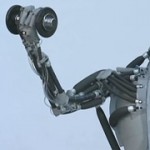Archive for 2007
Designing Safety-Critical Rehabilitation Robots
- Тип контента: Научная статья
- Номер документа: 6843
- Название документа: Designing Safety-Critical Rehabilitation Robots
- Номер (DOI, IBSN, Патент): 978-3-902613-04-2
- Изобретатель/автор: Stephen Roderick, Craig Carignan
- Правопреемник/учебное заведение: University of Maryland, Georgetown University
- Дата публикации документа: 2007-08-31
- Страна опубликовавшая документ: США
- Язык документа: Английский
- Наименование изделия: Не заполнено
- Источник: Rehabilitation Robotics, Book edited by Sashi S Kommu
- Вложения: Да
- Аналитик: Глаголева Елена
 In recent years, robots have made substantial in-roads in the medical field and are gradually finding their way into clinical practice. Intuitive Surgical’s da Vinci surgical robot broke ground in 1998 by performing the first tele-robotic surgery to repair a heart valve. Accuray’s CyberKnife radiotherapy robot began treating head, neck and upper spine tumors in 1999 by combining image guidance with a robotically-directed radiation beam. In 2002, Interactive Motion Technology began therapy of stroke patients with the InMotion2 robot, also known as the MIT-Manus . These devices and many others under development have provided researchers and doctors alike with capabilities not previously available.
In recent years, robots have made substantial in-roads in the medical field and are gradually finding their way into clinical practice. Intuitive Surgical’s da Vinci surgical robot broke ground in 1998 by performing the first tele-robotic surgery to repair a heart valve. Accuray’s CyberKnife radiotherapy robot began treating head, neck and upper spine tumors in 1999 by combining image guidance with a robotically-directed radiation beam. In 2002, Interactive Motion Technology began therapy of stroke patients with the InMotion2 robot, also known as the MIT-Manus . These devices and many others under development have provided researchers and doctors alike with capabilities not previously available.
Категория: Научные статьи | Нет комментариев »
Exoskeleton-Based Exercisers for the Disabilities of the Upper Arm and Hand
- Тип контента: Научная статья
- Номер документа: 7157
- Название документа: Exoskeleton-Based Exercisers for the Disabilities of the Upper Arm and Hand
- Номер (DOI, IBSN, Патент): 978-3-902613-04-2
- Изобретатель/автор: Ioannis Sarakoglou, Sophia Kousidou, Nikolaos G. Tsagarakis, Darwin G. Caldwell
- Правопреемник/учебное заведение: University of Salford, Manchester, UK, Italian Institute of Technology, Genoa, Italy
- Дата публикации документа: 2007-08-31
- Страна опубликовавшая документ: Австрия
- Язык документа: Английский
- Наименование изделия: Не заполнено
- Источник: Rehabilitation Robotics, Book edited by Sashi S Kommu
- Вложения: Да
- Аналитик: Глаголева Елена
 The impact of disability on society is great not only on direct treat-ment costs. Invaluable loss of human creative activity and mental wellbeing as well as productivity losses reflect the indirect impact on the disabled individual as well as on society as a whole. Stroke is the leading cause of disability in the industrialised countries. Every year, over 130,000 people in the U.K. suffer strokes, with 13,000 under retirement age. Ischemia or haemorrhage in the brain may be the cause of cerebral vascular accidents which result in strokes (Parker et al., 1986). Fortunately over 65% of patients survive but the majority does have residual disabilities with up to 1/3 having severe disabili-ties particularly in the upper limb and hand. Hemiplegia, the most common impairment resulting from stroke, leaves the survivor with a stronger unimpaired arm and a weaker impaired one (hemiparesis). Traumatic injuries as well as conditions like muscular dystrophy, arthritis and regional pain syndromes, also add to the major causes of disability and functional dependence. Deficits in motor control and coordination synergy patterns, spasticity and pain are some of the most common symptoms of these conditions (Parker et al., 1986).
The impact of disability on society is great not only on direct treat-ment costs. Invaluable loss of human creative activity and mental wellbeing as well as productivity losses reflect the indirect impact on the disabled individual as well as on society as a whole. Stroke is the leading cause of disability in the industrialised countries. Every year, over 130,000 people in the U.K. suffer strokes, with 13,000 under retirement age. Ischemia or haemorrhage in the brain may be the cause of cerebral vascular accidents which result in strokes (Parker et al., 1986). Fortunately over 65% of patients survive but the majority does have residual disabilities with up to 1/3 having severe disabili-ties particularly in the upper limb and hand. Hemiplegia, the most common impairment resulting from stroke, leaves the survivor with a stronger unimpaired arm and a weaker impaired one (hemiparesis). Traumatic injuries as well as conditions like muscular dystrophy, arthritis and regional pain syndromes, also add to the major causes of disability and functional dependence. Deficits in motor control and coordination synergy patterns, spasticity and pain are some of the most common symptoms of these conditions (Parker et al., 1986).
Категория: Научные статьи | Нет комментариев »
Rehabilitation Robotics
- Тип контента: Обзор технологии
- Номер документа: 8048
- Название документа: Rehabilitation Robotics
- Номер (DOI, IBSN, Патент): 978-3-902613-01-1
- Изобретатель/автор: Sashi S Kommu
- Правопреемник/учебное заведение: The Derriford Hospital and The Bristol Urological Institute Devon, United Kingdom
- Дата публикации документа: 2007-08-31
- Страна опубликовавшая документ: Австрия
- Язык документа: Английский
- Наименование изделия: Не заполнено
- Источник: Не заполнено
- Вложения: Да
- Аналитик: Глаголева Елена
 The coupling of several areas of the medical field with recent advances in robotic systems has seen a paradigm shift in our approach to selected sectors of medical care, especially over the last decade. Rehabilitation medicine is one such area. The development of advanced robotic systems has ushered with it an exponential number of trials and experiments aimed at optimising restoration of quality of life to those who are physically debilitated. Despite these developments, there remains a paucity in the presentation of these advances in the form of a comprehensive tool. This book was written to present the most recent advances in rehabilitation robotics known to date from the perspective of some of the leading experts in the field and presents an interesting array of developments put into 33 comprehensive chapters. The chapters are presented in a way that the reader will get a seamless impression of the current concepts of optimal modes of both experimental and applicable roles of robotic devices. Robotic instrument designs are combined with the results of experiments and trials in an applicable and practical way. The ethos of the book is unique in that there is a considerable emphasis on practical applicability in making real time changes to patient care. The book begins by exploring the inherent and unique challenges of paediatric rehabilitation and presents the robotic platforms upon which promising preliminary results were noted. It then explores the key elements of robotic safety critical systems and risk management issues, an area of great concern in the medical field at present. There is also an in depth look at the role of robotics from a mechanotronics and virtual reality standpoint. The concept of high safety rehabilitation systems using functional fluid is explored and the platform for further studies is introduced. The concept of powered wearable assistance and the role of exoskeleton devices pave the brink of an exciting era in rehabilitation robotics. Additional concepts explored involve the interaction-control between robot, patient and therapist. ‘Rehabilitation Robotics’ promises to be a valuable supple-mentary tool to all those involved in rehabilitation from the standpoint of the patient and affected families, the therapist and the robot. It also acts as a platform upon which researchers can gain a solid and evidence based approach towards the initiation of future projects.
The coupling of several areas of the medical field with recent advances in robotic systems has seen a paradigm shift in our approach to selected sectors of medical care, especially over the last decade. Rehabilitation medicine is one such area. The development of advanced robotic systems has ushered with it an exponential number of trials and experiments aimed at optimising restoration of quality of life to those who are physically debilitated. Despite these developments, there remains a paucity in the presentation of these advances in the form of a comprehensive tool. This book was written to present the most recent advances in rehabilitation robotics known to date from the perspective of some of the leading experts in the field and presents an interesting array of developments put into 33 comprehensive chapters. The chapters are presented in a way that the reader will get a seamless impression of the current concepts of optimal modes of both experimental and applicable roles of robotic devices. Robotic instrument designs are combined with the results of experiments and trials in an applicable and practical way. The ethos of the book is unique in that there is a considerable emphasis on practical applicability in making real time changes to patient care. The book begins by exploring the inherent and unique challenges of paediatric rehabilitation and presents the robotic platforms upon which promising preliminary results were noted. It then explores the key elements of robotic safety critical systems and risk management issues, an area of great concern in the medical field at present. There is also an in depth look at the role of robotics from a mechanotronics and virtual reality standpoint. The concept of high safety rehabilitation systems using functional fluid is explored and the platform for further studies is introduced. The concept of powered wearable assistance and the role of exoskeleton devices pave the brink of an exciting era in rehabilitation robotics. Additional concepts explored involve the interaction-control between robot, patient and therapist. ‘Rehabilitation Robotics’ promises to be a valuable supple-mentary tool to all those involved in rehabilitation from the standpoint of the patient and affected families, the therapist and the robot. It also acts as a platform upon which researchers can gain a solid and evidence based approach towards the initiation of future projects.
Категория: Подборки книг | 2 комментария »
Designing Safety-Critical Rehabilitation Robots
- Тип контента: Научная статья
- Номер документа: 7146
- Название документа: Designing Safety-Critical Rehabilitation Robots
- Номер (DOI, IBSN, Патент): 978-3-902613-04-2
- Изобретатель/автор: Stephen Roderick, Craig Carignan
- Правопреемник/учебное заведение: University of Maryland, Georgetown University
- Дата публикации документа: 2007-08-31
- Страна опубликовавшая документ: Австрия
- Язык документа: Английский
- Наименование изделия: Не заполнено
- Источник: Rehabilitation Robotics, Book edited by Sashi S Kommu
- Вложения: Да
- Аналитик: Глаголева Елена
 In recent years, robots have made substantial in-roads in the medical field and are gradually finding their way into clinical practice. Intuitive Surgical’s da Vinci surgical robot broke ground in 1998 by performing the first tele-robotic surgery to repair a heart valve (Salis-bury, 1998; Guthart & Salisbury, 2000). Accuray’s CyberKnife radiotherapy robot began treating head, neck and upper spine tumors in 1999 by combining image guidance with a robotically-directed radiation beam (Adler et al., 1997). In 2002, Interactive Motion Technology began therapy of stroke patients with the InMotion2 robot, also known as the MIT-Manus (Krebs et al., 2002). These devices and many others under development have provided researchers and doctors alike with capabilities not previously available.
In recent years, robots have made substantial in-roads in the medical field and are gradually finding their way into clinical practice. Intuitive Surgical’s da Vinci surgical robot broke ground in 1998 by performing the first tele-robotic surgery to repair a heart valve (Salis-bury, 1998; Guthart & Salisbury, 2000). Accuray’s CyberKnife radiotherapy robot began treating head, neck and upper spine tumors in 1999 by combining image guidance with a robotically-directed radiation beam (Adler et al., 1997). In 2002, Interactive Motion Technology began therapy of stroke patients with the InMotion2 robot, also known as the MIT-Manus (Krebs et al., 2002). These devices and many others under development have provided researchers and doctors alike with capabilities not previously available.
Категория: Научные статьи | Нет комментариев »
Создатели руки скопировали анатомию человека
- Тип контента: Новостная статья
- Номер документа: 2263
- Название документа: Создатели руки скопировали анатомию человека
- Номер (DOI, IBSN, Патент): Не заполнено
- Изобретатель/автор: Не заполнено
- Правопреемник/учебное заведение: Не заполнено
- Дата публикации документа: 2007-08-29
- Страна опубликовавшая документ: Россия
- Язык документа: Русский
- Наименование изделия: Не заполнено
- Источник: http://www.membrana.ru/particle/3222
- Вложения: Не заполнено
- Аналитик: Ридна Украина)))
 Фантастика стала ещё на один шажок ближе к реальности. Новая рука для робота — это замечательный пример комбинации принципов биомиметики и мехатроники. Увидев её, кто-то непременно вспомнит Терминатора, но изобретение должно найти массу мирных областей применения.
Фантастика стала ещё на один шажок ближе к реальности. Новая рука для робота — это замечательный пример комбинации принципов биомиметики и мехатроники. Увидев её, кто-то непременно вспомнит Терминатора, но изобретение должно найти массу мирных областей применения.
Категория: Двигатели | Нет комментариев »
Статистика
Категорий: 179
Статей всего: 2,003
По типу:
Видео: 36
Выдержка с форума: 1
Контактные данные: 12
Научная статья: 1388
Не заполнено: 5
Новостная статья: 317
Обзор технологии: 42
Патент: 219
Тех.подробности: 34
Тип: 1
Комментариев: 8,961
Изображений: 3,005
Подробней...
ТОР 10 аналитиков
-
Глаголева Елена - 591
Дмитрий Соловьев - 459
Helix - 218
Ридна Украина))) - 85
Наталья Черкасова - 81
max-orduan - 29
Елена Токай - 15
Роман Михайлов - 9
Мансур Жигануров - 4
Дуванова Татьяна - 3
Календарь
| Пн | Вт | Ср | Чт | Пт | Сб | Вс |
|---|---|---|---|---|---|---|
| « Ноя | ||||||
| 1 | 2 | 3 | 4 | 5 | 6 | 7 |
| 8 | 9 | 10 | 11 | 12 | 13 | 14 |
| 15 | 16 | 17 | 18 | 19 | 20 | 21 |
| 22 | 23 | 24 | 25 | 26 | 27 | 28 |
| 29 | 30 | 31 | ||||
Авторизация
Ошибка в тексте?
Выдели её мышкой!
И нажми Ctrl+Enter